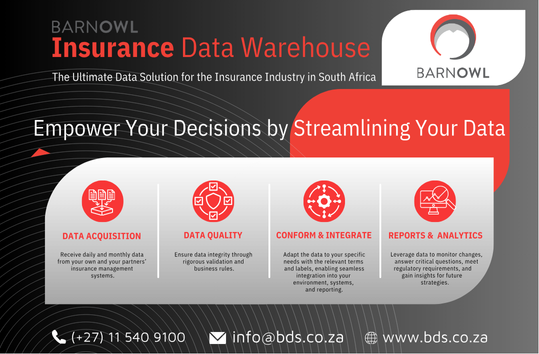In today’s insurance landscape, data has emerged as one of the most valuable assets. The industry is undergoing a rapid transformation driven by the increasing availability of data, advancements in technology, and regulatory demands.
To gain deeper insights into this shift, Tony van Niekerk spoke with Graham Blunn and Angus Black from BarnOwl Data Solutions. Our discussion covered the fundamental changes in data, its challenges, and how insurers can effectively manage and leverage data for better decision-making.
The Changing Landscape of Data -Over the past decade, the two most significant shifts in the world of data have been the exponential increase in data volumes and the heightened demand for quality. According to Angus Black, “The move towards data-driven decision-making has changed everything. In the past, decisions were often based on intuition or limited information. Now, businesses require data to justify and guide their actions.”
As companies rely more on data, they accumulate vast amounts of it. However, simply collecting data is not enough. Businesses must ensure that data is accurate, relevant, and structured in a way that allows for efficient analysis.
Challenges of Managing Legacy Data – One of the biggest challenges in the insurance sector is dealing with legacy data. Many insurers have collected large volumes of data without a clear strategy on how to use it. As Black noted, “What was considered useful data a decade ago may no longer be relevant today. Businesses must continuously assess and refine their data to ensure its quality.”
Insurance companies frequently upgrade systems, change products, and introduce new rating factors, which results in inconsistencies in legacy data. Moving from one system to another can lead to missing or incomplete information, making it difficult to utilise historical data effectively. Fixing legacy data is a complex and costly process that requires time and strategic planning.

Empower Your Decisions by Streamlining Your Data
With BARNOWL Insurance Data Warehouse: The Ultimate Data Solution for the Insurance Industry in South Africa.
For more information on how to empower your decisions by streamlining your data, visit bds.co.za
Defining and Measuring Data Quality – A critical aspect of data management is determining what constitutes quality data. According to Black, quality data must meet business needs and provide meaningful insights. “You can’t just collect data for the sake of it,” he explained. “It needs to be useful for decision-making and operations.”
To ensure data quality, businesses need to measure it using specific metrics. BarnOwl Data Solutions employs a data quality scoring system to help clients evaluate their data and identify gaps. This allows businesses to track improvements over time and maintain high standards of accuracy and reliability.
Ensuring Data Remains Up to Date – Once an insurer has cleaned and structured its data, the next challenge is maintaining its accuracy and compliance. Many organisations make the mistake of treating data cleaning as a one-time exercise. However, as Black emphasised, “Data management is an ongoing process. It requires constant monitoring, communication with brokers, and feedback loops to ensure accuracy.”
One of the most effective ways to maintain data quality is to establish clear processes for regular updates. By continuously validating data and working closely with brokers, insurers can prevent outdated or incorrect information from accumulating over time.
Leveraging External Data Sources – In addition to internal data management, insurers can enhance their datasets by integrating external sources. BarnOwl Data Solutions explores various ways to validate and enrich client data, such as:
- Identity verification – Ensuring policyholder details are accurate, such as ID numbers and company registration details.
- Geolocation validation – Using GPS coordinates to verify risk locations and ensure correct property addresses.
- Risk assessment – Analysing external data on crime rates, weather patterns, and other factors that impact insurance risk.
- Asset valuation – Confirming that insured assets, such as buildings and vehicles, are valued correctly.
These methods help insurers refine their risk models and improve underwriting accuracy, ultimately leading to better pricing and reduced claims volatility.
The Growing Importance of Data in Insurance – The role of data in insurance has shifted from being an operational necessity to a strategic asset. As Black pointed out, “Regulatory requirements and internal efficiencies have made data management a top priority for insurers. Companies that invest in their data infrastructure gain a significant competitive advantage.”
In the past, data was often an afterthought—something companies only focused on when they needed specific insights. Today, insurers recognise that strong data management is crucial for profitability, risk assessment, and regulatory compliance.
Building Skills for the Future – As data becomes increasingly central to the insurance industry, there is a growing need for skilled professionals who can manage and analyse it effectively. However, finding talent in this space remains a challenge. “We struggle to find people with the right skills straight out of university,” Black admitted. “But we’re seeing more data-specific roles emerging, which is a step in the right direction.”
Insurance companies must invest in developing their workforce to keep up with the evolving demands of data management. This includes training employees in data analytics, AI-driven decision-making, and regulatory compliance.
The insurance industry is at the epicentre of a data revolution. As insurers collect more data than ever before, the focus must shift to improving data quality, ensuring compliance, and leveraging advanced analytics. Companies that embrace these changes will be better positioned to make informed decisions, manage risks effectively, and provide superior customer experiences.
BarnOwl Data Solutions is at the forefront of this transformation, helping insurers navigate the complexities of data management. As Black concluded, “We’re happy to be part of the process, providing the tools and expertise needed to ensure data remains a valuable asset rather than a liability.”
For insurers looking to stay ahead, investing in data quality and strategic management is no longer optional—it’s a necessity for long-term success.

